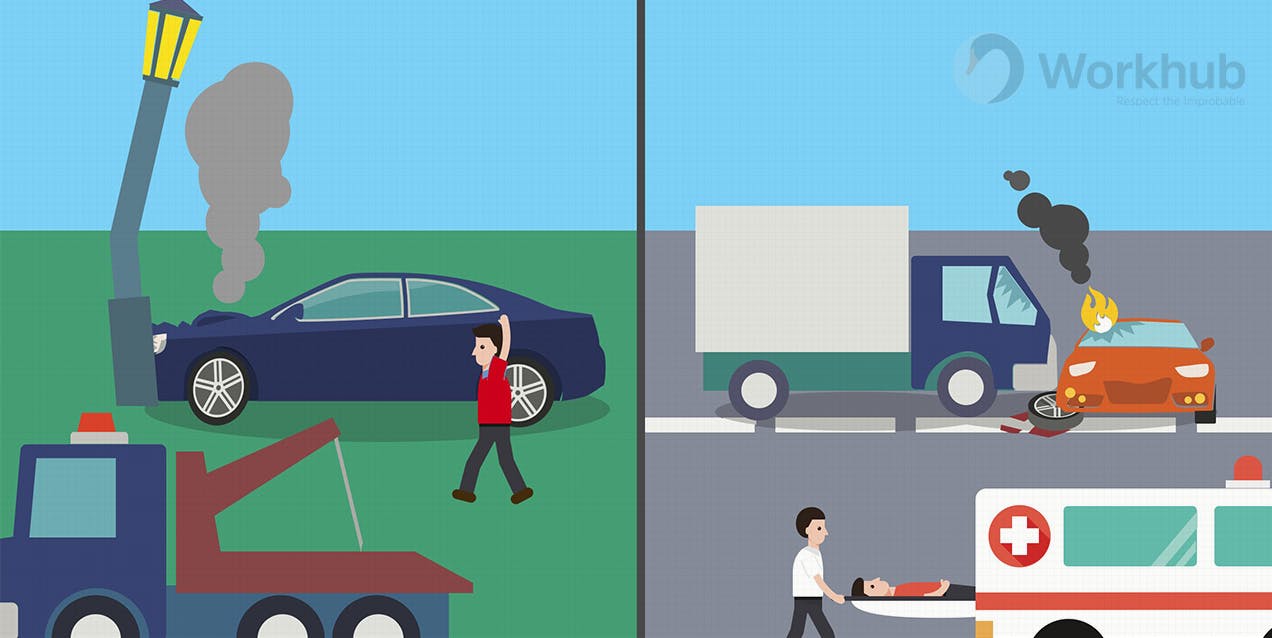
The difference between accidents and incidents is like the difference between fingers and thumbs. Remember the old saying "All thumbs are fingers, but not all fingers are thumbs"? Well, incidents and accidents are kinda like that.
Defining Accidents and Incidents
Accidents are defined as: . an unexpected event that may result in property damage, and does result in an injury or illness to an employee.
Incidents, on the other hand, are. an unexpected event that may result in property damage, but does not result in an injury or illness. Incidents are also called, "near misses," or "near hits."
So both events are unplanned, both can present damage to places or things, but only accidents result in illness or injury to a person. Basically, by definition, all accidents are incidents, but not all incidents are accidents.
As a matter of fact, incidents (near misses/hits) are much more common in the workplace than accidents. According to Australian risk management consultancy IPM, accidents as defined above make up only 2% of all workplace incidents.
Now let's take those definitions a step further and put them in the context of two of the most common workplace safety philosophies.
The OH&S world seems to be divided between all accidents are preventable and accidents happen. While many overseeing health and safety organizations around the world promote the all accidents are preventable approach to safety, many argue that it is impossible to foresee every possible "accident" and implement measures against them.
This has led to two schools of thought on how safety in the workplace should be practiced and both sides have passionate arguments as to why their preferred method is the right way of doing things.

Organizations who follow the all accidents are preventable philosophy, also known as Zero Accident Vision, will avoid using the word accident and be proactive in their safety approach.
Their core safety belief is that no one is injured in an accident. There may be flaws in a system or human error at play, but injuries and illnesses can be prevented by identifying and anticipating hazards before any harm occurs. Policies and procedures are implemented based on either past incidents, incidents in similar workplaces, and most importantly, from near misses/hits in their own organization.
In an article for OHSonline.com, Larry Wilson suggests that zero accidents is not within the scope of human reality:
The problem with "All injuries can be prevented" is that in order for this statement to be true, everybody would have to be watching what they were doing and thinking about what they were doing whenever they were moving. Because once they move or start to move, the only thing that tells them what they could be moving into is their eyes or their mind, with the exception of planes and ships that also use radar and sonar.
But most of us aren't using radar or sonar when we are walking, working, or driving; we're using our eyes and our minds, though none of us do it 100 percent of the time.
As much as we all like to think we have planned and prepared for every worst case scenario, the truth is that everyone overlooks something at some point. It is almost impossible to anticipate every single mistake or flaw that could lead to an illness or injury, regardless of how long organizations spend thinking of ways to make their workers safer.
Our FREE Incident Reporting software let's you collect data so that you can reduce the frequency and severity of accidents and near misses.
Some organizations don't believe you can foresee every hazard or danger present in the workplace. Often, the cause of these accidents is said to be a fluke, a one in a million chance of equipment failure or wrong place at the wrong time. These incidents lead to the creation or improvement of safety procedures and policies which are intended to stop the same scenario from playing out again in the future.
It also means that management teams are looking to reduce the number of injuries or illnesses that occur, not trying to prevent them outright.
This philosophy has some pretty strong critics, such as Pamela Ferrante,CSP, CHMM, president of JC Safety & Environmental, Inc. of Pittsburgh, PA, who stated in a webinar for Safety.BLR.com
An accident is the opposite of the fundamental intentions of a safety program, which is to find hazards, fix hazards, and prevent incidents. When we accept that accidents have no cause, we assume that they will happen again.
The Canadian Centre for Occupational Health and Safety (CCOHS) echoed the sentiment on their website, stating:
Canadian Centre for Occupational Health and Safety (CCOHS)
It is easy to feel as though this way of thinking is the wrong one. While the goal to reduce the number of accidents that occur acknowledges that they can do better, the hard truth is that these organizations are still planning for some accidents to inevitably take place.
The world of OH&S is full of debates, and like any other, you probably already have an idea of which side of the fence you stand on. Whether you stand by the Zero Accident philosophy, or you believe that Accidents Happen no matter how many controls are put in place, the important thing to remember is that no one WANTS to see anyone get hurt at work. Keep doing what feels right for you and your company. You never know which side of the fence you will end up on down the road.